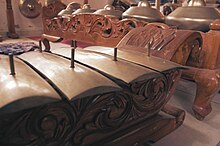|
Saron (instrument)
 The saron is a musical instrument of Indonesia, which is used in the gamelan. It normally has seven bronze bars placed on top of a resonating frame (rancak). It is usually about 20 cm (8 in) high, and is played on the floor by a seated performer. In a pelog scale, the bars often read 1-2-3-5-6-7 across (the number four is not used because of its relation to death[1]) (in kepatihan numbering); for slendro, the bars are 6-1-2-3-5-6-1; this can vary from gamelan to gamelan, or even among instruments in the same gamelan. Slendro instruments commonly have only six keys. It provides the core melody (balungan) in the gamelan orchestra. Varieties Sarons typically come in a number often sizes, from smallest to largest:
Each one of those is pitched an octave below the previous. The slenthem or slentho performs a similar function to the sarons one octave below the demung. Playing techniquesThe sarons are struck with a mallet (tabuh). Typically the striking mallet is angled to the right to produce a fuller sound. Demung and saron barung generally use a wooden mallet, while the peking mallet is made of a water buffalo horn, which gives it a shriller sound. The other hand is used to dampen the previous note by grasping the key, in order to prevent a muddy sound. On repeated notes, the note is usually dampened half a beat before it is struck again. The saron barung and demung usually play less often and more simple parts. These are the usual techniques for playing them:
Saron panerus has distinctive patterns which make it different from the other sarons. It usually plays more often, and keeps a constant beat going throughout a piece. Its playing techniques include:
History The earliest known appearance of a single-octave saron is in a relief at Borobudur, from the 9th century. It was formerly supposed that the saron derived from the decomposition of the gambang gangsa, after it fell out of use. Mantle Hood rejected this hypothesis, and associates the preference for a single octave with the characteristic shape of the cadence in the pathet. There is no evidence that the gambang gangsa is older than the saron; indeed, it may be younger.[2] See alsoFootnotes
References
|
||||||||
Portal di Ensiklopedia Dunia


